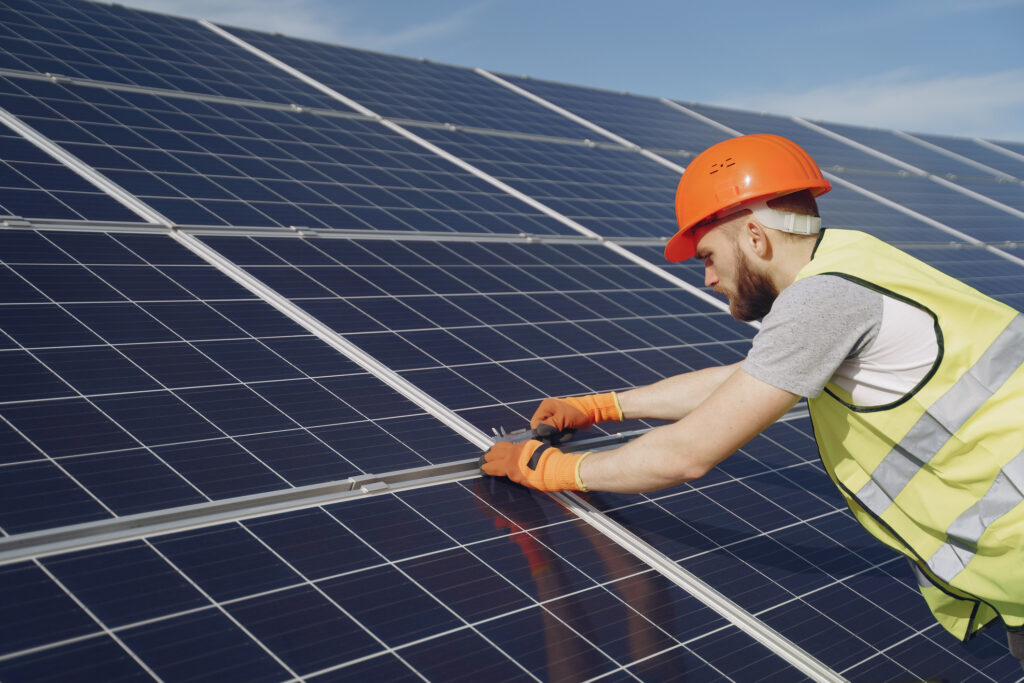
China now dominates global solar production, including by using forced labor. Can President Biden get the U.S. solar manufacturing industry back on track?
The Biden administration on Wednesday announced an ambitious new plan that would see nearly half of the nation’s electricity come from by solar energy by 2050. While it’s a noble idea, given the very real need to reduce carbon emissions to avoid the worst impacts of climate change, the specifics about how President Biden plans to implement this plan are scarce.
And here at the Alliance for American Manufacturing, we have one big question: Who exactly is going to build all of those new solar panels?
As I outlined in on the blog back on Aug. 25, America’s solar industry provides a case study for how the promise of a robust domestic manufacturing base for a new technology can go wrong. Despite billions of dollars in investments and the support of both the Bush and Obama administrations in the first decade of the 21st century, the U.S. has now lost much of its solar industry to China.
The U.S. once made 22% of the world’s solar panels. That number now stands at 1%.
China’s government utilized massive government subsidies, lax environmental standards, and forced labor practices to make its solar panels. It built up its domestic supply chain and kept coal power plants open to supply cheap electricity to make the panels. Then, it dumped its artificially cheap solar panels onto the global marketplace, suppressing U.S. solar manufacturers who abide by strict labor and environmental standards and free market rules.
As a result, American solar plants closed. The U.S. is now heavily reliant on China for its solar needs, which creates a real dilemma for Biden’s solar ambitions, given the fact that there’s strong evidence that China utilizes forced labor throughout its solar industry.
Should the United States build out its new solar panel installations with Made in China products, we will be complicit in a genocide. As Horizon Advisory researcher Emily de la Bruyere told AAM:
“As long as we in the U.S. continue to build our solar industry on Chinese sources, we are building on a foundation of forced labor. Global consumers of Chinese polysilicon-based photovoltaic and semiconductor goods implicitly support the sustained abuse of ethnic and religious minorities in China.”
The Biden administration seems to understand this, as it has issued bans on solar products from the Xinjiang region of China, citing the government’s use of forced Uyghur labor in the region.
But bans are not enough; the United States also must start producing a lot more solar panels as an alternative to Made in China products. If Biden wants to do this right, the United States needs to get to work on revitalizing its fledgling solar industry and growing domestic production, not just of solar panels themselves but of the supply chain needed to support all those new installations.
Right now, though, it’s unclear how that will happen. Much of Biden’s solar panel plan is unknown, and the New York Times reported that many “details will ultimately be decided by Congress.”
The bipartisan infrastructure legislation, recently passed by the Senate and headed for a vote in the House, offers some clues about what Congress may do. While the legislation includes $73 billion for clean energy transmission, it also left out a number of other clean energy provisions that were originally found in Biden’s American Jobs Plan.
The U.S. simply isn’t doing enough right now to compete. If Biden wants the United States to get 45% of its power needs from solar by 2050 – it sits at just 4% right now – Congress is going to need to get serious about investing in this critical sector and ramping up domestic solar production. Much more investment will be needed to scale up domestic industry, not only to meet Biden’s 2050 goal but also to ensure America’s solar future is Made in America.
And at the same time, the U.S. will need to use its trade tools to ensure a more level playing field for U.S. solar workers and manufacturers. Indeed, trade actions are perhaps the one thing that has allowed the U.S. solar manufacturers that remain to survive.
Tariffs were first placed on solar imports from China in 2012, and the Trump administration applied them to imports from all Chinese-owned companies in 2018. American solar manufacturers Auxin Solar Inc., and Suniva Inc. recently asked the International Trade Commission to extend those tariffs for four more years, and a group of U.S. solar manufacturers also filed recent petitions requesting investigations into Chinese companies that they say are circumventing tariffs already on the books by making products in places like Malaysia, Vietnam, and Thailand.
According to the Wall Street Journal, since tariffs were imposed solar panel production in the U.S. has tripled. First Solar Inc., cites the tariffs as a reason it could expand production; Auxin said the tariffs helped it stay in business.
Giving these companies an opportunity to succeed – and encouraging others to invest in the United States – must be part of the plan. And Biden is a guy who always has expressed a desire to help America’s working men and women. Indeed, the president welcomed labor leaders and union members to the White House on Wednesday, telling them that “we’re going to build back better. We have to, we must, we will. Because that’s who we are. That’s what America is.”
A major transition to solar-powered electricity provides a historic opportunity to do just that. But we’ve got to do it right by investing in America’s workers and manufacturers to ramp up domestic solar production and strengthen supply chains. Otherwise, Biden will merely transition the U.S. from a country once dependent on foreign oil to one reliant on Made in China solar panels.
